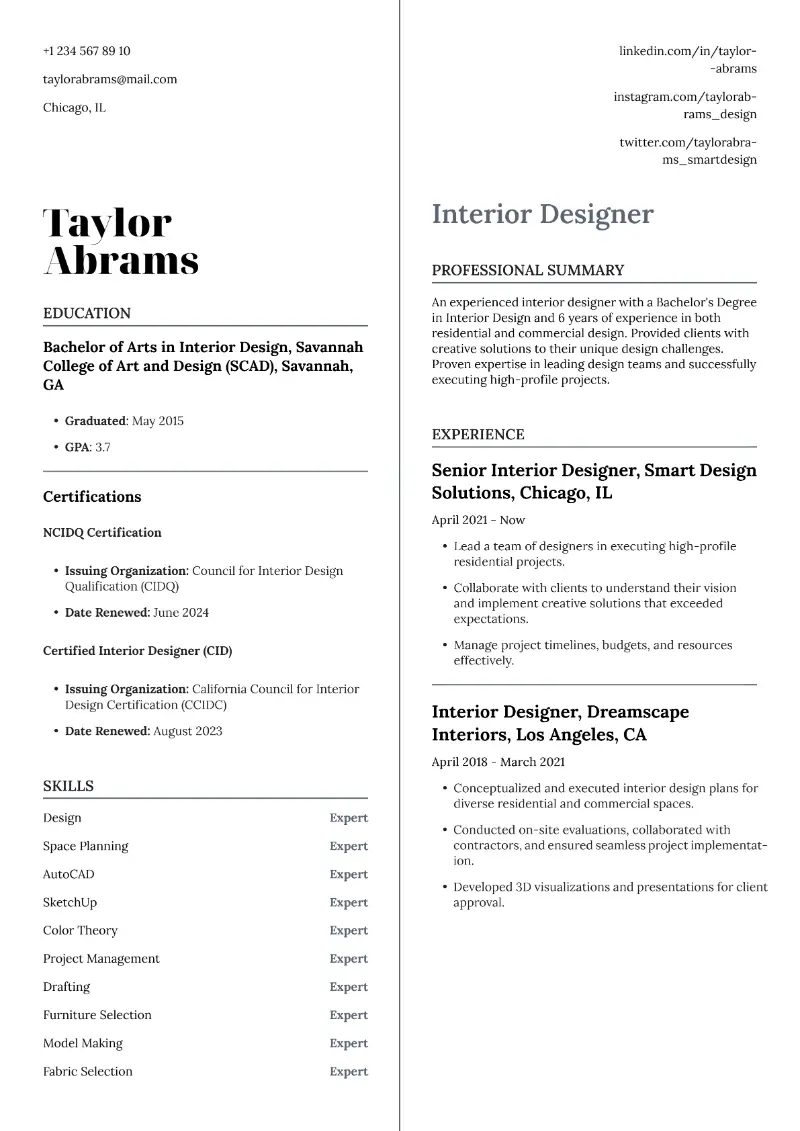Having the right interior design certificate can set you apart from the crowd and open doors to exciting opportunities. Whether you're just starting out or looking to advance your career, earning a recognized credential can enhance your skills, credibility, and marketability.
This article explores some of the top interior design certifications that can help you stand out in the creative industry.
Why are certifications important for interior designers?
Certifications play a crucial role in the professional development and success of interior designers. They serve as a mark of credibility, demonstrating expertise, knowledge, and commitment to the craft.
For clients and employers, a certificate in interior design offers assurance that the specialist is qualified to deliver work that meets professional standards.
Moreover, in many regions, interior designers must be certified to practice legally. This is particularly important when working on commercial projects or in specialized areas like sustainable design or healthcare facilities.
Plus, the process of training also promotes continued learning and professional growth. Most interior design certification programs require specialists to stay updated with industry trends, new technologies, and evolving regulations.
Here's how a designer resume might look with certifications:
General interior design certifications
NCIDQ (National Council for Interior Design Qualification)
- Issuing Organization: Council for Interior Design Qualification (CIDQ)
The NCIDQ certification is one of the most recognized credentials in the interior design industry, particularly in North America. It signifies proficiency in core interior design skills, including space planning, life safety, ethics, and building codes.
Requirements:
- Education. An accredited interior design degree (associate's, bachelor's, or master's).
- Experience. 2-4 years of work experience under a licensed or certified interior designer.
- Exams. Fundamentals Exam (IDFX), Professional Exam (IDPX), and the Practicum Exam (PRAC).
Benefits:
Recognized by many state and provincial licensing boards. It can be a requirement for practicing as a professional interior designer in certain jurisdictions.
CID (Certified Interior Designer)
- Issuing Organization: Certified Interior Decorators International (CIDI)
This certification for interior designers is ideal for those focusing on the aesthetic and styling aspects of spaces, such as color schemes, furniture, and accessories, rather than structural and functional elements.
- Requirements. Completion of a CID-accredited program or sufficient experience in the field.
- Exams. Written exam covering key topics like color theory, furniture styles, and business ethics.
Benefits:
Validates skills in styling, and provides credibility in the field of interior decoration.
CPHD (Certified Passive House Designer)
- Issuing Organization: Passive House Institute (PHI)
The CPHD certification is aimed at professionals focusing on energy efficiency and passive building design. While typically associated with architects, it is valuable for interior designers working on sustainable projects.
Requirements:
- Education: Experience in building or interior design.
- Exams: CPHD exam, which tests knowledge of Passive House principles, including energy modeling.
Benefits:
Expands expertise in high-performance, energy-efficient design. Ideal for designers working on low-energy projects.
Specialized interior design credentials
LEED AP (Leadership in Energy and Environmental Design Accredited Professional)
- Issuing Organization: U.S. Green Building Council (USGBC)
LEED Accreditation is a globally recognized standard for sustainable building practices, applicable to various professions, including interior design.
LEED is a rating system for the design, construction, and operation of high-performance green buildings. It evaluates various aspects of a building, including energy use, lighting, water, and material use.
There are different specialties, such as LEED AP BD+C (Building Design + Construction), LEED AP ID+C (Interior Design + Construction), and others, depending on the focus area.
- Requirements. No prerequisites, but understanding of green building practices is recommended.
- Exams. LEED Green Associate (entry-level), followed by LEED AP with Specialty (advanced).
Benefits:
Demonstrates expertise in sustainable design, which is increasingly important in modern interior projects.
NKBA (National Kitchen and Bath Association)
- Issuing Organization: National Kitchen and Bath Association (NKBA)
Professionals involved in the construction or renovation of kitchens and bathrooms can use this certification to demonstrate their understanding of design principles, improve client trust, and enhance their service offerings.
- Requirements. Vary by certification level, ranging from associate to certified master designer. Requires education and experience in kitchen and bath design.
- Exams. Several certification levels, such as Associate Kitchen & Bath Designer (AKBD), Certified Kitchen Designer (CKD), and Certified Master Kitchen and Bath Designer (CMKBD).
Benefits:
Recognized in the kitchen and bath design industry, enhancing credibility and access to resources.
WELL AP (WELL Accredited Professional)
- Issuing Organization: International WELL Building Institute (IWBI)
This course focuses on the health and well-being aspects of environments, an increasingly important area in design.
- Requirements. Familiarity with wellness design principles and the WELL Building Standard is recommended.
- Exams. The WELL AP Exam covers the Building Standard’s principles, including air, water, nourishment, light, fitness, comfort, and mind.
Benefits:
Positions designers to specialize in wellness-focused interiors, offering a competitive edge in sectors like corporate office design, healthcare, and residential projects.
NCBTMB (National Certification Board for Therapeutic Massage and Bodywork)
- Issuing Organization: National Certification Board for Therapeutic Massage and Bodywork (NCBTMB)
While primarily for massage therapists, this certification is relevant for designers specializing in wellness spaces, such as spas, to understand therapeutic environment
- Requirements. Completion of a recognized program in massage therapy or a related field, plus professional experience.
- Exams. The certification exam assesses knowledge of anatomy, physiology, therapeutic techniques, and business practices.
Benefits:
Provides insight into creating functionally supportive and aesthetically pleasing environments.
CGBP (Certified Green Building Professional)
- Issuing Organization: Green Building Initiative (GBI)
The CGBP certification is great for professionals who specialize in green building practices, focusing on sustainable design, energy efficiency, and environmentally friendly construction methods.
- Requirements. Candidates typically need to have relevant experience in green building or complete a recognized training program in sustainable design practices.
- Exams. The certification exam assesses knowledge of green building standards, sustainability principles, and environmental impact reduction techniques.
Benefits:
Particularly valuable for those working on projects aimed at achieving certifications like Green Globes or other sustainable building ratings.
FAQ about interior design certifications
- What is the difference between a certification and a license?
- Certification is a voluntary credential that demonstrates expertise, while a license is required by law to practice professionally in certain areas. Licensing requirements vary by state or country.
- How to get an interior design license?
- You typically need to meet the educational and experience requirements specific to your state or country. Check with your local licensing board for specific procedures.
- How much does it cost to become a certified interior designer?
- Costs can vary depending on the certification. For example, the NCIDQ certificate fees are typically several hundred dollars, and there may also be costs for study materials and preparatory courses.
- How often do I need to renew my interior designer certificates?
- Requirements vary by certification. For the NCIDQ, certification is valid for two years, after which you need to complete continuing education requirements and pay a renewal fee.
- Can I get certified if I’m self-taught or have an informal background in interior design?
- Most certification programs require formal education and professional experience.
- Where can I find more information about interior design certifications?
- Visit the official websites of certification bodies like the NCIDQ or IDS. You can also consult with industry professionals and educational institutions for detailed information on requirements.
Conclusion
Investing in the best interior decorator certification can significantly impact your career trajectory, offering you the tools and recognition needed to excel.
By choosing the interior design certification programs that align with your professional goals, you can enhance your expertise, build your portfolio, and gain the confidence to take on more complex projects.
Whether you're aiming to specialize in a niche area or broaden your overall design skills, the credentials highlighted in this article can provide the foundation for your success.
Create your professional Resume in 10 minutes for FREE
Build My Resume




